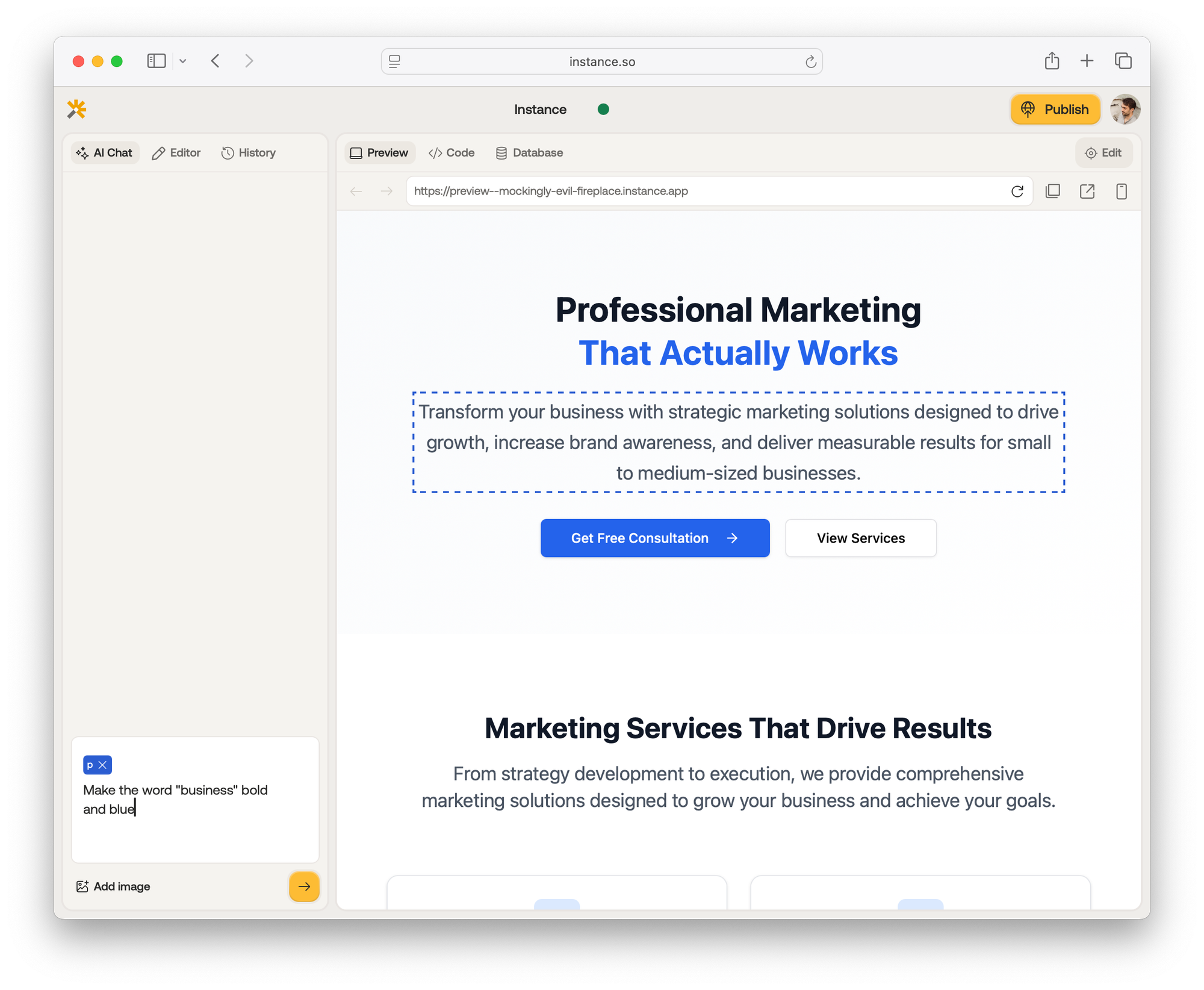Prompting
When working on your app with Instance, you'll primarily communicate with the AI to make changes and build toward your vision. The messages you send to the AI — the large language model (LLM) — are called prompts.
Prompting 101 – How to talk so Instance will listen
Welcome to our friendly field guide, which will help you get more value from our AI builder and vibe code more successfully.
Most people drop a one‑liner into an AI chat box and hope for magic. It works, but you can get much more out of your messages. The difference between a shrug‑worthy answer and watching Instance auto‑generate your whole app step-by-step is prompting skill.
1. What is prompting, really?
A prompt is nothing more than the text you feed Instance so it can predict the next best piece of code. Because LLMs are pattern machines, not mind‑readers, the raw material you give them is everything.
2. Why it matters inside Instance
Instance can draft fancy UI, including amazing animations, wire up the whole back-end logic, and install everything you need to build the product you envision from idea to launch. However, it only works if it knows precisely what you want.
3. How the model "thinks"
The LLM doesn't think, despite appearing to do so. Understanding the model's limitations helps you vibe code better. The following table will help you shape your prompts to avoid common pitfalls.
| Reality check | What it means for you |
|---|---|
| LLMs predict tokens, they don't "understand" | Add as much additional info as needed to help the LLM predict what you want |
| The first & last lines of a prompt get extra attention | Put the mission‑critical bits up front and end with the concrete ask |
| The context window (the amount of data the LLM can use) is finite | Most of the context window is used for the actual code that LLM works with; if your additional information is too long, use ChatGPT to sum it up |
| LLMs bluff when unsure | Be precise and provide all needed information to complete the task and always validate if the result is what you were looking for |
4. A simple prompt skeleton that never lets us down
To give your prompt some structure, think about a prompt skeleton like the following:
Context: one‑sentence background
Task: the single thing you want done
Guidelines: style, tone, format, libraries
Constraints: hard rules (“don't touch authentication”, etc.)
Example
Context: We're building a customer portal
Task: Only display the open orders for a given customer on as new dashboard page
Guidelines: Style the page similarly to the overview page
Constraints: Don't touch the database functionality; don't only load the open orders but all orders for a given customer
5. Foundational tactics & bite‑size examples
To get the most out of vibe coding with Instance, have a look at the following tactics:
| Tactic | Why it matters | Example |
|---|---|---|
| One request at a time | Avoids half-finished work | "Add a dashboard that loads all products" (check) → "Now paginate results and only show 50 at a time" |
| Reference concrete files | Fewer side effects | "In the dashboard, add a button to order the products" |
| Show, don't tell | Anchors the model | Select an element or reference the concrete file; Instance will add the reference to the LLM call |
| State no-go zones | Prevents collateral edits | "Do not modify the landing page" |

6. Troubleshooting cheat‑sheet
Running into errors is a natural part of development, whether you code everything by hand or use AI to create the code using Instance as your AI app builder.
Here are some tips to help you get unstuck when building apps with Instance:
| Symptom | Try this |
|---|---|
| The LLM “forgets” earlier directions | Inject a quick recap: “Reminder: this is a customer portal for the customers of my company” |
| Output drifts off topic | Re-assert constraints at the end of the prompt |
| Hallucinated API calls | Paste the official docs of the API you want to use and ask Instance to rely only on that text |
| Too much code in a file | Ask Instance to refactor a page into managable and scalable pieces |
7. Final thoughts
Prompting is not sorcery; it's tech writing for a hyper-literal coworker. Nail the structure, iterate as if you're pair-programming with a knowledgeable but forgetful coding expert, and Instance will feel less like an unpredictable oracle and more like the turbo-charged teammate it's designed to be.
Happy building!